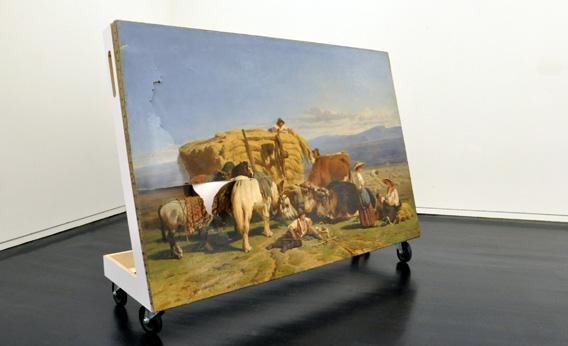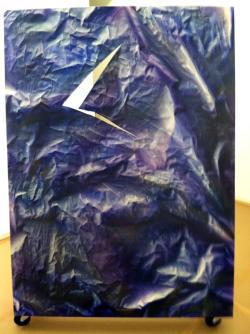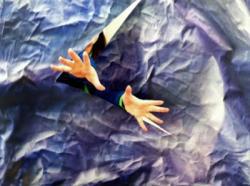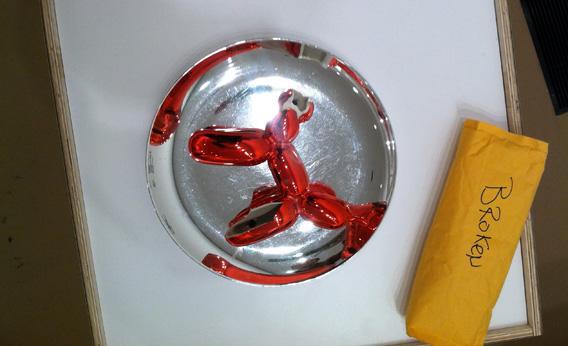The first painting I saw upon entering “No Longer Art,” a curious and elegiac exhibition at the Arthur Ross Architecture Gallery at Columbia University through Dec. 20, was a cowboy-and-Indian painting. Given that I’d just returned from my grandfather’s memorial in California, it seemed fitting; one of the very few non-political arguments I’d had with my grandfather, whose aesthetics were wildly inconsistent, was about a cowboy-and-Indian painting. I made fun of a cowboy sunrise that popped up on TV—I’d actually been to the featured artist’s studio in Florida—and my grandfather, once an Air Force pilot, groused, “Aww John, that’s one of our top guys.”
The damage to the work, quite severe, gave me license to get over myself and look more closely, which I did—only to discover the work was not cowboy-and-Indian themed, nor was it recent. The work was a 160-year-old painting of country life in France: La Moisson, by Alexandre Dubuisson. It was propped on a castered gurney, a 1-foot gash opened in its surface, right between the horses and the hay bales.

Courtesy John Reed.
On the way up to the gallery, I’d torn a similar gash, smaller but similar, in the pants of my blue suit. I’d been wearing the suit for three days. I wore it with a blue tie and a gray shirt to my grandfather’s memorial. He was 92, I tell everyone, so it wasn’t too difficult. After the service, I swapped into fresh socks, fresh underwear, and a clean shirt, and wore the suit on the red-eye—California back to New York. I came home, took a nap, woke up, swapped out the necessaries again, and wore the suit for the day; redux the next day. During all this, I had it in the back of my mind to find another navy blue suit—that maybe this one was going—and I’d stop into stores and not find what I envisioned. The lesson that maybe I was trying to reteach myself: Some things can’t be replaced.
Right before I cast off for California, I got an email that said the “No Longer Art” show, which I’d hoped to run up to before I left, had been pushed back a week due to hurricane Sandy. Sandy had decimated parts of Chelsea, and the art world, largely downtown, was slow to power up. Countless galleries lost major works, and in the post-Sandy chaos, Chelsea, like the rest of downtown, was teeming with insurance agents. “No Longer Art,” curated by an artist and friend I’ve written about before, seemed suddenly, uncannily apropos.
Elka Krajewska first had the notion for “No Longer Art” in May of 2009. I know it’s been a huge travail—mounting an exhibition of art that is not art was a seemingly endless series of legal hoops and delicate negotiations. I talked to my father about going up with me to see the show—he’s friendly with Elka as well—but he said he was afraid it would be too upsetting, that he had some damaged paintings of his own to cope with, and that he was planning to go up after he’d gathered his strength (it was his father who had passed away). His trepidation was surprising to me, and I defended Elka’s premise—her instinct as an artist, to expose the presumed but artificial proximity of art and marketplace, was spot on, and I was more interested in the show than the damage.
To give a brief explanation of art that is no longer art: Sometimes the cost of restoring a work of art exceeds the value of the work, in which case the insurer declares a total loss, and the work is declared no longer art—that is, of no market value. The damage can range from obvious to subtle—from a ripped painting or shattered sculpture to a wrinkle in a photographic print, or mold damage which can’t be seen at all. As it wouldn’t do to send the not-artwork to the crematorium—the work might be of scholarly value, or might one day be worth repairing, or might one day be more easily repaired—the work is stored, not dead, but in a state of indefinite coma. The Salvage Art Institute, Elka’s curatorial brainchild, collects and exhibits not-art.
It is, of course, prima facie impossible to make art not-art. The very attempt to do something so futile can in itself be construed as nothing other than an act of art—a creative attempt to do something impossible. The existence of a known or powerful work so defiled that it has fallen from grace is the exemplification of pathos: the great, and the fall. But it might be possible to strip art of market value. And if that is possible, the question then becomes: If art has no market value, is it art?
When we arrived (a friend went up to the show with me), Javier, who was at the front desk, promptly informed us that we could do what we wanted—touch the works, photograph them, roll them around, pick them up, turn them over, whatever. This was a not-exhibition of not-art, and as not-gallery-goers, we were free to behave as advanced primates.

Courtesy John Reed.
The works were presented in tandem with their insurance appraisals—their death warrants, or at least their DNRs. Javier cautioned us that while I could take pictures of the works, I could not take pictures of the appraisals—a tangible reminder of Elka’s difficulty in exhuming this not-art. The works were dusty, unkempt, not pristine. They were markedly not-viewed. I was immediately drawn to a Jeff Koons dog balloon sculpture. My wife worked for Koons years ago, and we own an almost identical dog balloon piece. Part of owning the porcelain dog balloon is the fear of breaking it, and here the circle was complete—the thing had indeed been dropped. The shattered pieces accompanied the work, in a padded envelope.

Courtesy John Reed.
The non-value of the work imbued the individual pieces with an elevated humanity. As if patients in a hospital ward, the pieces were vulnerable and democratized. Sans glass, I realized, this was probably about as close to a Robert Rauschenberg as a mere mortal was likely to get. I’m not encouraging anyone—I’m just saying—but you could probably catch a moment when Javier was distracted, and lick it. But despite the immediacy of the works, the most powerful impression was that of the presence of the artists. Through the damage, the seams of the works were opened—the rivets in the dog balloon were now visible—and a viewer had a vision of the act of creation, which is primary to art, while market-value is not. No matter the legal value, the creative act remains. Trying to make art not-art—it’s a little like asking yourself to forget something.
As my friend and I skated from work to work—rolling the pieces on their gurneys—I felt a surge of elation, perhaps akin to what a spy or a tomb-raider might feel. I snapped my pictures, and kept asking Javier about the death warrants. He finally seemed to relent, saying maybe, he’d have to ask someone. I was encouraged, and picked up a death warrant at one of the displays. The warrant was in a larger, spiral-bound booklet. Flipping through, I saw that each of the 20 booklets on display was a complete set of warrants. Javier eyeballed me, and I put it back down.

Courtesy John Reed.
My grandfather, in the last days of his life, told my father, “I’m flying that plane again; it’s not scary, so high up.” Art is a simultaneous experience: something infinitely fragile yet absolutely indestructible. Art is most comfortable within the danger zone, occupying uncertainties between the market and the personal, the acceptable and the not acceptable, the forgivable and the unforgivable. Which is not to aggrandize what I’ve done, because I really can’t believe it’s so bad—though I’m just not sure. As we were winding up, some more people came into the gallery, and Javier went over to tell them to touch anything, and I seized the opportunity—and my editor urges me not to tell you what happened next. Suffice it to say, I’m poring over the warrants now. Words, whole sections are blacked out. We can’t reproduce the pages in their entirety (legal, sigh) but if I might, I will relate a cautionary tale of the book lice (order Pscoptera, who consume mainly fruiting bodies of fungi) and the green mold:
“By accepting this opinion, you agree that it will never be used for any other purpose, nor will anyone ever show a copy of it to anyone who is not associated with the Property under consideration,” reads the warrant. “The damage … will indicate to both an educated and uneducated buyer that the work has been damaged and treated. … It is the said appraiser’s opinion that the mold on the property can be seen as a permanent devaluation.”
